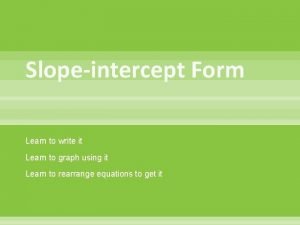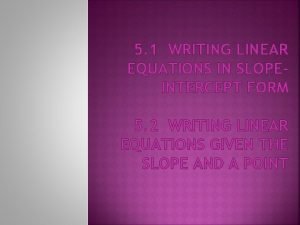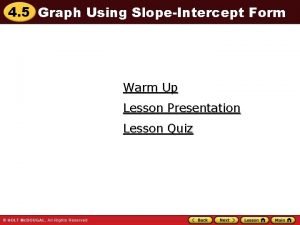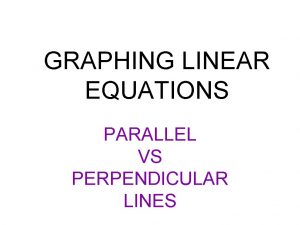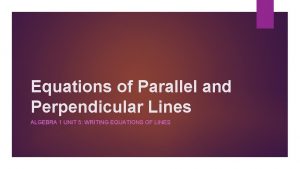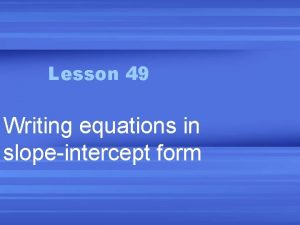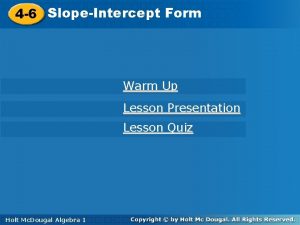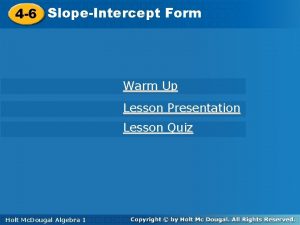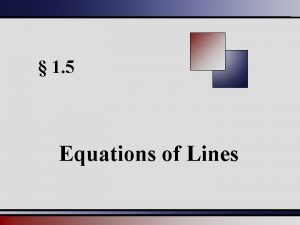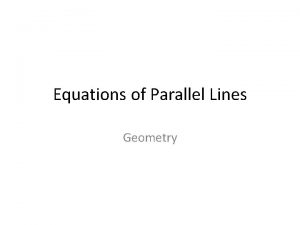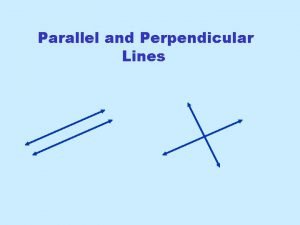3 5 Equations of Lines SlopeIntercept Form of











- Slides: 11

§ 3. 5 Equations of Lines

Slope-Intercept Form of a Line Slope-Intercept Form When a linear equation in two variables is written in the slope-intercept form, y = mx + b m is the slope and (0, b) is the y-intercept of the line. y = 3 x – 4 y The slope The -intercept is is 3. (0, -4). Martin-Gay, Beginning and Intermediate Algebra, 4 ed 2

Slope-Intercept Form Example: Find the slope and y-intercept of the line – 3 x + y = – 5. First, we need to solve the linear equation for y. By adding 3 x to both sides, y = 3 x – 5. Once we have the equation in the form of y = mx + b, we can read the slope and y-intercept. slope is 3 y-intercept is (0, – 5) Martin-Gay, Beginning and Intermediate Algebra, 4 ed 3

Slope-Intercept Form Example: Find the slope and y-intercept of the line 2 x – 6 y = 12. First, we need to solve the linear equation for y. – 6 y = – 2 x + 12 Subtract 2 x from both sides. y= x– 2 Divide both sides by – 6. Since the equation is now in the form of y = mx + b, slope is y-intercept is (0, – 2) Martin-Gay, Beginning and Intermediate Algebra, 4 ed 4

The Point-Slope Form of the Equation of a Line The point-slope form of the equation of a line is slope (x 1, y 1) point on the line where m is the slope of the line and (x 1, y 1) is a point on the line. Martin-Gay, Beginning and Intermediate Algebra, 4 ed 5

The Point-Slope Form Example: Find an equation of the line whose slope is 5 and contains the point (4, 3). Write the equation in slope-intercept form. m = 5, x 1 = 4, y 1 = 3 y – y 1 = m(x – x 1) y – (– 3) = 5(x – 4) y + 3 = 5 x – 20 y = 5 x – 23 Substitute the values for m, x 1, and y 1. Simplify and distribute. Subtract 3 from both sides. Martin-Gay, Beginning and Intermediate Algebra, 4 ed 6

Finding the Equation Given Two Points Example: Find an equation of the line that passes through ( 2, 1) and (7, 4). Write the equation in slope-intercept form. Find the slope of the line. Use the point-slope form to find the equation. Continued. Martin-Gay, Beginning and Intermediate Algebra, 4 ed 7

Finding the Equation Given Two Points Example continued: Distribute. Add 1 to each side. Simplify. Martin-Gay, Beginning and Intermediate Algebra, 4 ed 8

Using the Point-Slope Form Example: In 1990, Window World , Inc. had 50 employees. In 2005, the company had 85 employees. Let x represent the number of years after 1990 and let y represent the number of employees. a. ) Assume that the relationship between years and number of employees is linear, and write an equation describing this relationship. b. ) Use the equation to predict the number of employees in 2000. Continued. Martin-Gay, Beginning and Intermediate Algebra, 4 ed 9

Using the Point-Slope Form Example continued: a. ) The year 1990 is represented by x = 0. 2005 is 15 years after 1990, so 2005 is represented by x = 15. The two points (0, 50) and (15, 85) will be used to find the equation. Substitute the values for m, x 1, and y 1. Distribute. Add 50 to both sides. Martin-Gay, Beginning and Intermediate Algebra, 4 ed Continued. 10

Using the Point-Slope Form Example continued: c. ) Use the equation employees in 2000. to predict the number of In 2000, x = 10. Martin-Gay, Beginning and Intermediate Algebra, 4 ed 11
 What is slope intercept form definition
What is slope intercept form definition Slopeintercept form
Slopeintercept form Slopeintercept form
Slopeintercept form Slopeintercept form
Slopeintercept form Present continuous affirmative and negative
Present continuous affirmative and negative 9-3 polar and rectangular forms of equations
9-3 polar and rectangular forms of equations Translating chemical equations
Translating chemical equations Parallel lines and transversals vocabulary
Parallel lines and transversals vocabulary Lines in space
Lines in space Perpendicular vs parallel equations
Perpendicular vs parallel equations Equations of parallel lines gcse questions
Equations of parallel lines gcse questions Writing equations of parallel and perpendicular lines
Writing equations of parallel and perpendicular lines
